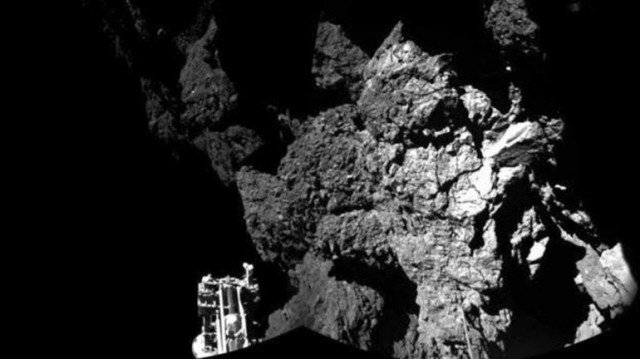Scientists have confirmed that the Philae lander has detected organic molecules on the surface of Comet 67P.
Carbon-containing “organics” are the basis of life on Earth and may give clues to chemical ingredients delivered to our planet early in its history.
The compounds were picked up by a German-built instrument designed to “sniff” the comet’s thin atmosphere.
Other analyzes suggest the comet’s surface is largely water-ice covered with a thin dust layer.
The European Space Agency (ESA) craft touched down on the Comet 67P on November 12 after a 10-year journey.
It has not been disclosed which molecules have been found, or how complex they are.
The results are likely to provide insights into the possible role of comets in contributing some of the chemical building blocks to the primordial mix from which life evolved on the early Earth.
Preliminary results from the Mupus instrument, which deployed a hammer to the comet after Philae’s landing, suggest there is a layer of dust 10-20cm thick on the surface with very hard water-ice underneath.
The ice would be frozen solid at temperatures encountered in the outer Solar System – Mupus data suggest this layer has a tensile strength similar to sandstone.
After bouncing off the surface at least twice, Philae came to a stop in some sort of high-walled trap.
Scientists had to race to perform as many key tests as they could before Philae’s battery life ran out at the weekend.
A key objective was to drill a sample of “soil” and analyze it in Cosac’s oven. But, disappointingly, the latest information suggests no soil was delivered to the instrument.
Scientists are hopeful however that as Comet 67P/Churyumov-Gerasimenko approaches the Sun in coming months, Philae’s solar panels will see sunlight again. This might allow the batteries to re-charge, and enable the lander to perform science once more.
The lander’s Alpha Particle X-ray Spectrometer (APXS), designed to provide information on the elemental composition of the surface, seems to have partially seen a signal from its own lens cover – which could have dropped off at a strange angle because Philae was not lying flat.
[youtube mMcOy2PpvTc 650]
Philae probe is now stable and sending first pictures after a historic comet landing, but there are concerns about its battery life.
After two bounces, the first one about 1 mile back out into space, the lander settled in the shadow of a cliff, 1 mile from its target site.
It may be problematic to get enough sunlight to charge its batteries.
Launched in 2004, the European Space Agency (ESA) mission hopes to learn about the origins of our Solar System.
It has already sent back the first images ever taken on the surface of a comet.
ESA’s Rosetta satellite carried Philae on a 10-year, 4 billion-mile journey to Comet 67P/Churyumov-Gerasimenko, which reached its climax on November 12.

Philae probe has sent first pictures after a historic comet landing (photo ESA)
After showing an image that indicates Philae’s location – on the far side of a large crater that was considered but rejected as a landing site – the head of the lander team Dr. Stefan Ulamec said: “We could be somewhere in the rim of this crater, which could explain this bizarre… orientation that you have seen.”
Figuring out the orientation and location is a difficult task, he said.
“I can’t really give you much more than you interpret yourself from looking at these beautiful images.”
The team is continuing to receive “great data” from several different instruments on board Philae.
It may be possible to reconfigure Philae’s landing gear and “hop” to a new location, but Dr. Stefan Ulamec said there may not be enough time to do the analysis required for such a risky strategy.
“There is a limited amount of battery power there and the solar panels are not really illuminated, so we don’t know precisely how long it’s going to last,” said Rosetta mission manager Dr. Fred Jansen.
Philae robot probe, the size of a washing machine, was dropped from the Rosetta satellite on Wednesday and spent seven hours travelling down to the icy body.
News of the “first” landing was confirmed at about 16:05 GMT on November 12.
Controllers re-established radio communication with the probe on cue on November 13 after a scheduled break, and began pulling of the new pictures.
These show the feet of the lander and the wider cometscape. One of the three feet is not in contact with the ground.
Philae is stable now, but there is still concern about the longer-term situation because the probe is not properly anchored – the harpoons that should have hooked it into the surface did not fire on contact. Neither did its feet screws get any purchase.
[youtube LGuFVWM96SI 650]


